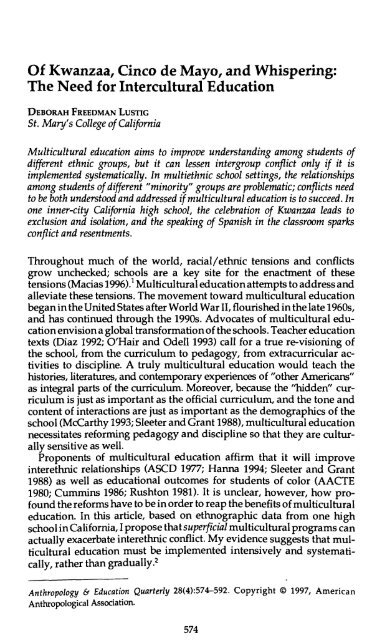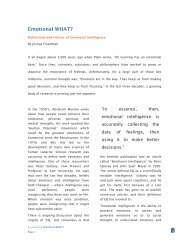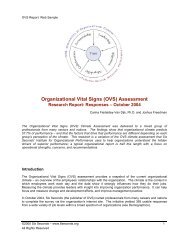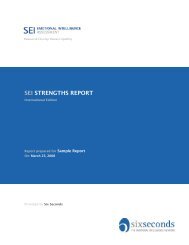Of Kwanzaa, Cinco de Mayo, and Whispering: The Need for ...
Of Kwanzaa, Cinco de Mayo, and Whispering: The Need for ...
Of Kwanzaa, Cinco de Mayo, and Whispering: The Need for ...
You also want an ePaper? Increase the reach of your titles
YUMPU automatically turns print PDFs into web optimized ePapers that Google loves.
<strong>Of</strong> <strong>Kwanzaa</strong>, <strong>Cinco</strong> <strong>de</strong> <strong>Mayo</strong>, <strong>and</strong> <strong>Whispering</strong>:<strong>The</strong> <strong>Need</strong> <strong>for</strong> Intercultural EducationDEBORAH FREEDMAN LUSTIGSt. Mary's College of Cali<strong>for</strong>niaMulticultural education aims to improve un<strong>de</strong>rst<strong>and</strong>ing among stu<strong>de</strong>nts ofdifferent ethnic groups, but it can lessen intergroup conflict only if it isimplemented systematically. In multiethnic school settings, the relationshipsamong stu<strong>de</strong>nts of different "minority" groups are problematic; conflicts needto be both un<strong>de</strong>rstood <strong>and</strong> addressed if multicultural education is to succeed. Inone inner-city Cali<strong>for</strong>nia high school, the celebration of <strong>Kwanzaa</strong> leads toexclusion <strong>and</strong> isolation, <strong>and</strong> the speaking of Spanish in the classroom sparksconflict <strong>and</strong> resentments.Throughout much of the world, racial/ethnic tensions <strong>and</strong> conflictsgrow unchecked; schools are a key site <strong>for</strong> the enactment of thesetensions (Macias 1996). 1 Multicultural education attempts to address <strong>and</strong>alleviate these tensions. <strong>The</strong> movement toward multicultural educationbegan in the United States after World War II, flourished in the late 1960s,<strong>and</strong> has continued through the 1990s. Advocates of multicultural educationenvision a global trans<strong>for</strong>mation of the schools. Teacher educationtexts (Diaz 1992; O'Hair <strong>and</strong> O<strong>de</strong>ll 1993) call <strong>for</strong> a true re-visioning ofthe school, from the curriculum to pedagogy, from extracurricular activitiesto discipline. A truly multicultural education would teach thehistories, literatures, <strong>and</strong> contemporary experiences of "other Americans"as integral parts of the curriculum. Moreover, because the "hid<strong>de</strong>n" curriculumis just as important as the official curriculum, <strong>and</strong> the tone <strong>and</strong>content of interactions are just as important as the <strong>de</strong>mographics of theschool (McCarthy 1993; Sleeter <strong>and</strong> Grant 1988), multicultural educationnecessitates re<strong>for</strong>ming pedagogy <strong>and</strong> discipline so that they are culturallysensitive as well.Proponents of multicultural education affirm that it will improveinterethnic relationships (ASCD 1977; Hanna 1994; Sleeter <strong>and</strong> Grant1988) as well as educational outcomes <strong>for</strong> stu<strong>de</strong>nts of color (AACTE1980; Cummins 1986; Rushton 1981). It is unclear, however, how profoundthe re<strong>for</strong>ms have to be in or<strong>de</strong>r to reap the benefits of multiculturaleducation. In this article, based on ethnographic data from one highschool in Cali<strong>for</strong>nia, I propose that superficial multicultural programs canactually exacerbate interethnic conflict. My evi<strong>de</strong>nce suggests that multiculturaleducation must be implemented intensively <strong>and</strong> systematically,rather than gradually. 2Anthropology & Education Quarterly 28(4):574-592. Copyright © 1997, AmericanAnthropological Association.574
Lustig <strong>Kwanzaa</strong>, <strong>Cinco</strong> <strong>de</strong> <strong>Mayo</strong>, <strong>and</strong> <strong>Whispering</strong> 575I agree with Wallace that we should 'View multiculturalism not as anobdurate <strong>and</strong> unchanging i<strong>de</strong>ological position but as an opportunity <strong>for</strong>ongoing critical <strong>de</strong>bate" (1993:252). <strong>The</strong> <strong>de</strong>bate has to inclu<strong>de</strong> observations<strong>and</strong> evaluation of (supposedly) multicultural education as it existsin schools today. My critique of multicultural education rests on thecontrast between the i<strong>de</strong>al of multicultural education <strong>and</strong> the extremelysuperficial version that I observed. 3Token multicultural re<strong>for</strong>ms can intensify ethnic group conflict if theyneglect the power relations among the oppressed—between "minority"groups—as well as if they neglect the power relations between thedominant <strong>and</strong> the oppressed. Discussions of multicultural educationusually revolve around the relationship of stu<strong>de</strong>nts of color to EuropeanAmerican stu<strong>de</strong>nts, staff, curricula, <strong>and</strong> pedagogies (McCarthy <strong>and</strong>Willis 1995). But racial tensions, fears, <strong>and</strong> hatreds also exist betweendifferent "minorities" in many multiethnic schools (Foley 1990, but seeGrant <strong>and</strong> Sleeter 1986 <strong>for</strong> an exception). 4 In this article I will <strong>de</strong>scribehow, at one Cali<strong>for</strong>nia high school, interethnic tensions are aggravatedby educational re<strong>for</strong>ms that highlight each ethnic group both sequentially<strong>and</strong> in isolation.Although at some schools multicultural education is implementedintensively, many more schools are quick to claim that they provi<strong>de</strong>multicultural education. "Many well-intentioned but superficial schoolpractices para<strong>de</strong> as multicultural education, such as food fairs, costumeshows, <strong>and</strong> window-dressing contributions by people of color" (Sleeter1991:9).I observed interethnic relations <strong>and</strong> the attempts at multiculturaleducation at one inner-city high school, King High, in Pineview, Cali<strong>for</strong>nia.5 <strong>The</strong> Pineview school district <strong>and</strong> community activists, in their 1990"Agenda <strong>for</strong> Positive Change," espouse a thorough multicultural re<strong>for</strong>m.6[Pineview] is a community rich in cultures, ethnicities, <strong>and</strong> languages. <strong>The</strong>schools must promote <strong>and</strong> reflect that richness.This means:• School personnel are educated about the cultures <strong>and</strong> histories representedamong the children they teach.• School personnel are as diverse as the stu<strong>de</strong>nt body, providing the sensitivity<strong>and</strong> language skills to bridge school with home.• Textbooks are infused with the contributions of all peoples.• Diverse values <strong>and</strong> traditions are integrated in every aspect of the educationalprogram.• Education is no longer presented from an exclusively European-centeredpoint of view.• Instruction <strong>and</strong> programs are <strong>de</strong>signed <strong>for</strong> stu<strong>de</strong>nts to interact harmoniouslyacross racial, ethnic, cultural, <strong>and</strong> language differences.Three years after this impressive outline was published, multiculturaleducation at King High was still limited to posters on the wall <strong>and</strong> specialassemblies. Like King High, most schools go no further than a superficial
576 Anthropology & Education Quarterly Volume 28,1997addition of multicultural events <strong>and</strong> heroes, even though scholars agreethat multicultural education should be much more than "add cultures<strong>and</strong> stir" (Arvizu <strong>and</strong> Saravia-Shore 1990). At King High, these verysuperficial attempts at multicultural education actually exacerbatedgroup conflict, but I suggest that a truly multicultural education with afocus on process <strong>and</strong> boundaries could alleviate interethnic tensions.Twenty years ago, Cortes said that although multicultural educationshould be more than isolated events <strong>and</strong> units, their addition was apositive first step.<strong>The</strong> recognition of ethnic groups through school events <strong>and</strong> the study of singleethnic groups through special units <strong>and</strong> courses has been a valuable <strong>and</strong> longoverdue addition to our educational process... they have intrinsic value <strong>and</strong>...they provi<strong>de</strong> the cutting edge of multicultural educational re<strong>for</strong>m. [Cortes1977:39]Most schools have not gone beyond this first step. Moreover, this firststep, in isolation, is not only ina<strong>de</strong>quate, but it is actually dangerous. AsHanna warns, "Besi<strong>de</strong>s the lack of evi<strong>de</strong>nce that multicultural educationprograms do what they are supposed to do, multicultural programs mayhave uninten<strong>de</strong>d consequences" (1994:72). Token multicultural educationcan inflame interethnic resentments, surely an uninten<strong>de</strong>d consequence.In her case study of the implementation of a multicultural"school within a school," Ulichny found that multiculturalism in practicemeant "different foods, festivals, <strong>and</strong> '<strong>for</strong>eign' languages," insteadof "an exploration of societal patterns of discrimination <strong>and</strong> inequalitythat are based on class, race, <strong>and</strong> place of origin" (1996:343). <strong>The</strong> emphasison cultural heritage worsened interethnic relations because stu<strong>de</strong>ntsof some ethnic groups were resentful of those who seemed to have amonopoly on "culture."I suggest that instead of starting from the "special events" approach,we rework the mo<strong>de</strong>l of multicultural education. Successful multiculturaleducation requires an analysis of the dynamics of stu<strong>de</strong>nt relationsacross all ethnic groups—"minority" <strong>and</strong> "majority"—<strong>and</strong> must beginwith the particular culture of each school, as well as encompass broa<strong>de</strong>rsocietal patterns of access to power <strong>and</strong> privilege. Some scholars haveargued <strong>for</strong> a <strong>de</strong>epening of multicultural education toward whatMcCarthy calls "critical multiculturalism,... a process that goes beyond'inclusivit/ <strong>and</strong> emphasizes relationality <strong>and</strong> multivocality" (1993:290).As I will explain later, I prefer the term intercultural education to <strong>for</strong>egroundthe relationships between <strong>and</strong> the diversity within ethnicgroups.Ethnographic Setting <strong>and</strong> Research MethodsKing High is located in Pineview, a large city in Cali<strong>for</strong>nia. Pineviewis a poor city, <strong>and</strong> King High has the highest concentration of low-incomestu<strong>de</strong>nts of any Pineview high school. 7 <strong>The</strong> ethnic makeup of the stu<strong>de</strong>nts
Lustig <strong>Kwanzaa</strong>, <strong>Cinco</strong> <strong>de</strong> <strong>Mayo</strong>, <strong>and</strong> <strong>Whispering</strong> 577is 80 percent African American, 10 percent Latino, <strong>and</strong> 10 percent otherethnicities. Approximately 1,500 stu<strong>de</strong>nts are enrolled at King High, buton any day only about half of them are present.My analysis of interethnic relations <strong>and</strong> the multicultural ef<strong>for</strong>ts atKing is drawn from a larger ethnographic study of teen mothers <strong>and</strong>their school experiences (Lustig 1997). King High has a largely selfcontainedprogram to enable teen mothers to finish school (the School-Age Parent, or SAP, program). During the year-<strong>and</strong>-a-half that I spentat the SAP program, about 80 percent of these stu<strong>de</strong>nts were AfricanAmerican, 10 percent were Latina, <strong>and</strong> 10 percent were Asian American.In the course of the school year over one hundred stu<strong>de</strong>nts enrolled inthe SAP program, but only about 25 stu<strong>de</strong>nts atten<strong>de</strong>d more or lessregularly. 8 I was at the school four full days a week, spending most ofmy time with the teen mothers in the three classrooms used by the SAPprogram. Some SAP stu<strong>de</strong>nts were mainstreamed into "regular" (non-SAP) classes, <strong>and</strong> I occasionally accompanied them there as well. <strong>The</strong>quotes from stu<strong>de</strong>nts, teachers, <strong>and</strong> administrators are from my fieldnotes <strong>and</strong> taped interviews. In the school setting, it often seemed naturalto take my field notes during classes <strong>and</strong> assemblies. During lunch,support group, <strong>and</strong> other times when it would have been intrusive totake notes, I took notes as soon as possible afterwards, either during thenext class period or that afternoon at home.While my main concern in this article is interethnic relations amongstu<strong>de</strong>nts, teachers <strong>and</strong> administrators could play a vital role in amelioratingthose relations. I will address teachers' feelings about interethnicconflict, multicultural education, <strong>and</strong> their responsibilities as teachers.Although I did not conduct <strong>for</strong>mal interviews with teachers <strong>and</strong> administrators,I had long conversations with ten teachers (all of the aca<strong>de</strong>mic<strong>and</strong> "support services" teachers in the King High SAP program as wellas some of the SAP teachers at other Pineview schools) <strong>and</strong> brieferinteractions with several of the administrators. I took notes on theseconversations shortly after they took place. I also atten<strong>de</strong>d most staffmeetings at the King High SAP program <strong>and</strong> several of the districtwi<strong>de</strong>SAP meetings, including the orientation at the beginning of the year <strong>and</strong>the midyear retreat, <strong>and</strong> I took notes during these meetings.In the SAP program in Pineview <strong>and</strong> at King High, almost all theadministrators are African American. In the SAP program, almost all theaca<strong>de</strong>mic teachers are European American, while almost all the "supportservices" teachers, who teach nutrition, parenting, prenatal education,health, <strong>and</strong> career planning, are African American. This distribution isproblematic <strong>for</strong> four reasons: first, the alignment of European Americanswith aca<strong>de</strong>mic subjects rein<strong>for</strong>ces the association between aca<strong>de</strong>micsuccess <strong>and</strong> "acting white" (Fordham 1988); second, the EuropeanAmerican teachers, because of their ethnicity, feel particularly ina<strong>de</strong>quateto <strong>de</strong>al with the ethnic conflicts that arise; third, the Latinas are left
578 Anthropology & Education Quarterly Volume 28,1997with no Latino adults at school; <strong>and</strong> fourth, the ethnic makeup of thestaff is not seen as problematic by the administrators.According to one teacher, Ms. Wells, the aca<strong>de</strong>mic teachers wereconcerned about the patterning of diversity among the staff <strong>and</strong> told theadministrators that they thought aca<strong>de</strong>mic teachers of color should behired. <strong>The</strong> director downplayed their concerns by referring to the diversityamong the staff as a whole <strong>and</strong> pointed to the un<strong>de</strong>niable fact ofbudget cutbacks, which were leading to layoffs, not hiring.At the SAP staff orientation be<strong>for</strong>e the school year began, the directorlau<strong>de</strong>d the program <strong>for</strong> having such an ethnically diverse staff: "Nowwe can really serve the diverse population of this city <strong>and</strong> this program."She overlooked the staff distribution <strong>and</strong> assignments: the few AsianAmerican <strong>and</strong> Latino staff members were in the district office or the otherteen mother programs in the district; the European Americans were allaca<strong>de</strong>mic teachers; <strong>and</strong> the African Americans were primarily child carestaff, support services teachers, <strong>and</strong> administrators. Furthermore, herassumption that a diverse staff would automatically make the SAPprogram culturally sensitive proved to be unfoun<strong>de</strong>d.I conducted taped interviews with 75 teen mothers, of whom half wereor had been SAP stu<strong>de</strong>nts at King High. <strong>The</strong> interviews covered a wi<strong>de</strong>range of subjects, but the questions relevant to this article were, "Whathas it been like <strong>for</strong> you growing up [black/Latina/white/Asian]? Haveyou ever experienced racism or prejudice against you in school? Whatdo you think about how the different groups get along at school?" I alsoasked about the ethnic makeup of the schools the in<strong>for</strong>mant had atten<strong>de</strong>d<strong>and</strong> asked other questions relevant to each in<strong>for</strong>mant's particularsituation. For example, if the young woman had a child with a partnerof a different ethnic background, I asked about that; if she had beenpresent at one of the problematic events or inci<strong>de</strong>nts I had observed, Iasked about that.At best, the relationships between the Latino <strong>and</strong> African Americanstu<strong>de</strong>nts at King are characterized by indifference <strong>and</strong> self-segregation,<strong>and</strong> at worst, by violence <strong>and</strong> hostility. In the teen mother program,indifference <strong>and</strong> self-segregation predominate. I observed that stu<strong>de</strong>ntswould not even ask to borrow a pen or a ruler from someone of adifferent ethnic group. In one instance, a stu<strong>de</strong>nt shared a bag of c<strong>and</strong>ywith everyone in the room except the one stu<strong>de</strong>nt of a different ethnicgroup. When the stu<strong>de</strong>nts group themselves <strong>for</strong> work or lunch, theyalmost always self-segregate by ethnicity. In the school at large, there areoccasional fights across ethnic lines that sometimes escalate into feuds.At times the principal puts requests in the school bulletin pleading withstu<strong>de</strong>nts of one ethnic group not to respond to an inci<strong>de</strong>nt in whichmembers of their group have been attacked by another.<strong>The</strong> teachers at King High are no less vulnerable to racial tensions thanthe stu<strong>de</strong>nts. According to one of the SAP teachers, at one volatile facultymeeting teachers openly called each other racists. Moreover, he told me
Lustig <strong>Kwanzaa</strong>, <strong>Cinco</strong> <strong>de</strong> <strong>Mayo</strong>, <strong>and</strong> <strong>Whispering</strong> 579that some King High teachers sit in the staffroom <strong>and</strong> make racistcomments about other teachers <strong>and</strong> stu<strong>de</strong>nts. (<strong>The</strong>re are 61 teachers atKing High; the two full-time <strong>and</strong> four part-time SAP teachers at Kinghave little to do with the other teachers). I felt this tension when Iintroduced myself at a King High faculty meeting. In contrast to mywarm reception in the SAP program, other King teachers were quitehostile, not to me personally but to the prospect of another study. OneAfrican American teacher exclaimed, '<strong>The</strong>y'll approve rat studies, butthey won't approve black studies!" Although the school district hasapproved "black" studies <strong>and</strong> offers it as an elective, the teacher'scomment indicates that she felt that the "black" studies program wasina<strong>de</strong>quate; she saw a parallel between the <strong>de</strong>arth of African <strong>and</strong> AfricanAmerican studies <strong>and</strong> the potentially colonial implications of a EuropeanAmerican researcher at a predominantly African American school.She was metaphorically suggesting a contrast between African Americanstudies, which i<strong>de</strong>ally provi<strong>de</strong>s stu<strong>de</strong>nts with a view of AfricanAmericans as subjects or agents, <strong>and</strong> educational research that portraysAfrican Americans as "research subjects" or "rats."<strong>The</strong> school situation is a reflection, although not a perfect mirror, ofthe community, where ethnic conflicts frequently erupt in local politics<strong>and</strong> on the streets. Ethnic groups battle with each other over shrinkingresources: everyone seems to feel that if one group advances, the otherslose ground. Conflicts over bilingual education illustrate this generalpattern: Latino <strong>and</strong> Asian American parents struggle to re<strong>for</strong>m ina<strong>de</strong>quatebilingual programs, while African American parents resent theextra funding <strong>and</strong> attention that their children are not getting. '<strong>The</strong> battleover whose culture counts, particularly from the perspective of stu<strong>de</strong>nts<strong>and</strong> the communities they come from, is becoming more visibly a battleamong so-called minority cultures <strong>and</strong> only invisibly one of white versusother" (Ulichny 1996:334, emphasis in original).Strength in NumbersAt King, where most of the stu<strong>de</strong>nts <strong>and</strong> administrators are AfricanAmerican, the African American stu<strong>de</strong>nts appear to be in a position ofdominance over the Latino stu<strong>de</strong>nts. This "dominance" is only relative,of course, <strong>and</strong> does not negate the racism that African American stu<strong>de</strong>ntsexperience outsi<strong>de</strong> school. Moreover, their dominance is not absolute,but rather varies from situation to situation. King High's multiculturalef<strong>for</strong>ts overwhelmingly favor African American culture, suggesting thatmulticultural resources are committed in proportion to the number ofstu<strong>de</strong>nts of each group. <strong>Kwanzaa</strong> <strong>and</strong> Black History Month are celebrated,African dance is taught, rooms are <strong>de</strong>corated with posters celebratingAfrica <strong>and</strong> African Americans, <strong>and</strong> Africa is emphasized in socialstudies. <strong>The</strong> school, however, is by no means Afrocentric; rather, it isquite traditional <strong>and</strong> Eurocentric: the teaching methods are based onindividual achievement <strong>and</strong> competition, <strong>and</strong> the history books are
580 Anthropology & Education Quarterly Volume 28,1997largely peopled by European <strong>and</strong> European American men. 9 As onestu<strong>de</strong>nt in U.S. history remarked, "I'm already to page 142, <strong>and</strong> I haven'tread about a single black person/' As one teacher remarked, "[Administrators]say we should make the curriculum multicultural, but theynever do anything. <strong>The</strong>y never come see what I'm teaching." She waspointing out that there is no follow-through to the rhetoric used byadministrators. For example, the SAP mission statement refers to "excellencethrough diversity," but I saw no concrete manifestations of thisphilosophy.In other words, multicultural education at King was a veneer ofcultural relevance over a Eurocentric educational system. This veneerwas not directly tied to the lives <strong>and</strong> experiences of the stu<strong>de</strong>nts. Forexample, most of the African American stu<strong>de</strong>nts did not celebrate <strong>Kwanzaa</strong>at home, so while they may have enjoyed learning about it, it wasnot their (inner-city African American) culture that they saw reflected aspart of the curriculum. 10 Moreover, the African American veneer exclu<strong>de</strong>dthe Latino, Asian American, <strong>and</strong> European American stu<strong>de</strong>nts.<strong>The</strong> Latino <strong>and</strong> Asian American stu<strong>de</strong>nts did not see their heritagecelebrated as the African American <strong>and</strong> European American stu<strong>de</strong>ntsdid. <strong>The</strong> non-African American stu<strong>de</strong>nts were further exclu<strong>de</strong>d becauseit was never clear that the Afrocentric events <strong>and</strong> materials should be <strong>for</strong>all the stu<strong>de</strong>nts, although stu<strong>de</strong>nts may have engaged with the activitiesdifferently, <strong>de</strong>pending on their own background.To a large extent—<strong>and</strong> paradoxically—the exclusion stemmed fromthe failure of teachers to explicitly acknowledge that they have stu<strong>de</strong>ntsof different ethnicities. Race <strong>and</strong> ethnicity were rarely discussed inclassrooms, so during an event like <strong>Kwanzaa</strong>, there was no discussionof how non-African American stu<strong>de</strong>nts could or should relate to theproceedings. <strong>The</strong> assumption of exclusivity <strong>and</strong> the resultant hostilitysurfaced most clearly during special events that were nominally multiculturalbut were actually monocultural.<strong>Kwanzaa</strong>To celebrate <strong>Kwanzaa</strong>, an African theater group came to work withthe teen mothers to prepare a per<strong>for</strong>mance that inclu<strong>de</strong>d acting, dancing,<strong>and</strong> a rite of passage <strong>for</strong> the participants. <strong>The</strong> production was a majorun<strong>de</strong>rtaking, involving about two months of preparation. It was a remarkablypositive experience <strong>for</strong> the per<strong>for</strong>mers: the directors wereskilled at encouraging the stu<strong>de</strong>nts to do their best, <strong>and</strong> they <strong>and</strong> theaudience were pleased by the results. Rehearsals took place during classtime <strong>and</strong> inclu<strong>de</strong>d frequent references to African women <strong>and</strong> theirstrengths <strong>and</strong> roles. When rehearsals first began, all the stu<strong>de</strong>nts in theSAP program had to go, <strong>and</strong> everyone participated. Yet as the weekswent by, a few of the African American stu<strong>de</strong>nts <strong>and</strong> all the non-AfricanAmerican stu<strong>de</strong>nts stopped coming to rehearsals. 11 One of the AfricanAmerican stu<strong>de</strong>nts who stopped participating was pregnant <strong>and</strong> felt the
Lustig <strong>Kwanzaa</strong>, <strong>Cinco</strong> <strong>de</strong> <strong>Mayo</strong>, <strong>and</strong> <strong>Whispering</strong> 581dancing was too strenuous; perhaps the others were uncom<strong>for</strong>tableabout per<strong>for</strong>ming in front of an audience, or did not like the <strong>de</strong>m<strong>and</strong>splaced on them by the directors. <strong>The</strong> Latinas <strong>and</strong> Asian Americansstopped because, as one said, "It's all about African women—it's not <strong>for</strong>me." Through this attrition, the nonparticipants missed out on a valuableexperience. Since the nonparticipants inclu<strong>de</strong>d some African Americans,the pattern of ethnic separation was less obvious; 12 nevertheless, theprocess tacitly told everyone involved that African American culturewas relevant only to African Americans.<strong>Cinco</strong> <strong>de</strong> <strong>Mayo</strong>Up until <strong>Cinco</strong> <strong>de</strong> <strong>Mayo</strong>, no assemblies or special events had celebratedLatino cultures. Just be<strong>for</strong>e <strong>Cinco</strong> <strong>de</strong> <strong>Mayo</strong>, the teen mothers wentto a conference on African American women. None of the Latinas went.One of them explained, "I'm tired of African American this <strong>and</strong> AfricanAmerican that. <strong>The</strong>y never have anything <strong>for</strong> us. I feel left out. <strong>Cinco</strong> <strong>de</strong><strong>Mayo</strong> is coming <strong>and</strong> they haven't planned anything." Notice her convictionthat an event based on a particular culture is "<strong>for</strong>" stu<strong>de</strong>nts of thatculture.King High did have a <strong>Cinco</strong> <strong>de</strong> <strong>Mayo</strong> assembly, which inclu<strong>de</strong>d thesinging of the Mexican national anthem. Most of the African Americansrefused to rise <strong>for</strong> the singing, although they were repeatedly told to doso. While their reluctance stemmed largely from apathy <strong>and</strong> a generalizedresistance to authority, Latinos interpreted their refusal as hostile<strong>and</strong> disrespectful. <strong>The</strong> following year, during the <strong>Cinco</strong> <strong>de</strong> <strong>Mayo</strong> assembly,the Latino stu<strong>de</strong>nts dancing on stage went into the audience <strong>and</strong>invited other stu<strong>de</strong>nts (mostly African American) to dance with them.<strong>The</strong>y joined in willingly, <strong>and</strong> the positive <strong>and</strong> upbeat mood corroboratesmy intuition that the African American stu<strong>de</strong>nts were unwilling to st<strong>and</strong><strong>for</strong> a national anthem, rather than unwilling to participate in a celebrationof Latino cultures.<strong>Cinco</strong> <strong>de</strong> <strong>Mayo</strong> was the only time I saw an example of truly multiculturaleducation—paradoxically, it took place out of school. <strong>The</strong> casemanagers organized a <strong>Cinco</strong> <strong>de</strong> <strong>Mayo</strong>/Mother's Day celebration <strong>for</strong> teenmothers from the entire county. 13 <strong>The</strong> event consisted of speeches <strong>and</strong>per<strong>for</strong>mances about <strong>Cinco</strong> <strong>de</strong> <strong>Mayo</strong> <strong>and</strong> Mexican culture, per<strong>for</strong>mancesaddressed to urban teens in general (skits about violence <strong>and</strong> safe sex),<strong>and</strong> per<strong>for</strong>mances by African American rappers. In general, the stu<strong>de</strong>ntsenjoyed the event, which was more mult /cultural than others. In particular,one speaker ma<strong>de</strong> the only attempt I saw in a year-<strong>and</strong>-a-half to showhow the history or culture of one ethnic group could be relevant tostu<strong>de</strong>nts of other ethnicities. A Latino community lea<strong>de</strong>r, talking aboutMexican history <strong>and</strong> <strong>Cinco</strong> <strong>de</strong> <strong>Mayo</strong>, <strong>de</strong>scribed how the small, un<strong>de</strong>requippedMexican army had <strong>de</strong>feated the seemingly more powerfulFrench army when it inva<strong>de</strong>d Mexico in 1862. He explained, "All of you,whether you're Latina, black, white, Asian, you're facing a lot. You're
582 Anthropology & Education Quarterly Volume 28,1997trying to bring your kids up right. You're up against drugs, violence,poverty. But you can do it. Just think of the Mexican soldiers—no onethought they could win, but they did, <strong>and</strong> you can too/' <strong>The</strong> audiencerespon<strong>de</strong>d with cheers <strong>and</strong> clapping. This speaker was unusual: heacknowledged the presence of different ethnic groups in the room,pointed out to them their common problems, <strong>and</strong> suggested that theycould all be inspired by Mexicans of long ago.<strong>The</strong> success of the <strong>Cinco</strong> <strong>de</strong> <strong>Mayo</strong>/Mother's Day event provi<strong>de</strong>d amo<strong>de</strong>l of "something <strong>for</strong> everyone." Some of the teachers <strong>and</strong> administratorsof the SAP program had been concerned about the relativelyheavy emphasis on African American culture throughout the year,discussing at staff meetings their <strong>de</strong>sire to inclu<strong>de</strong> other cultures. As oneadministrator said, "We have to do something <strong>for</strong> the Latina girls." Butthey did not discuss how the non-African American stu<strong>de</strong>nts could orshould relate to African American material, nor did they ever express aconcern that the African American stu<strong>de</strong>nts were missing out by notbeing exposed to Latino cultures. <strong>The</strong>y, like the stu<strong>de</strong>nts, work on theassumption that curricula focusing on one culture are "<strong>for</strong>" stu<strong>de</strong>nts ofthat culture.In an attempt to be more inclusive, the following year's winter holidayevent was not only a <strong>Kwanzaa</strong> celebration. Instead, it was called WinterHolidays Around the World. <strong>The</strong> event consisted of tabletop displays ofdifferent cultures <strong>and</strong> their holidays <strong>and</strong> a brief introduction to each oneby teachers <strong>and</strong> community members. <strong>The</strong> affair was a dismal failure:the stu<strong>de</strong>nts were inattentive <strong>and</strong> ru<strong>de</strong> during the presentations. <strong>The</strong><strong>for</strong>mat provi<strong>de</strong>d a microcosm of the token multicultural educationpracticed at King High: the achievements <strong>and</strong> culture of each group werepresented in isolation from other groups, even when they were allinclu<strong>de</strong>d in the same event. In contrast, at the <strong>Cinco</strong> <strong>de</strong> <strong>Mayo</strong>/Mother'sDay celebration, connections were <strong>for</strong>ged across ethnic lines.Teachers <strong>and</strong> the "Com<strong>for</strong>t Zone"I have i<strong>de</strong>ntified three major weaknesses in the token multiculturaleducation at King High: (1) the allocation of multicultural resources inproportion to the ethnic makeup of the stu<strong>de</strong>nt body; (2) the implicationthat an event based on one culture is only <strong>for</strong> members of that ethnicgroup; <strong>and</strong> (3) the presentation of different cultures in isolation fromeach other. <strong>The</strong>se factors combined to drive wedges between the differentethnic groups at the school. True, they did not cause these tensions,but they reflected <strong>and</strong> rein<strong>for</strong>ced problems that exist in the society atlarge.<strong>The</strong> teachers <strong>and</strong> the school are culpable, however, <strong>for</strong> their failure toaddress ethnic conflict. A problem at King, one that is not addressed byexisting multicultural ef<strong>for</strong>ts, is that interethnic conflict is quelled asquickly as possible without addressing the un<strong>de</strong>rlying tensions thatprovoke conflict. A classroom inci<strong>de</strong>nt illustrates how the teachers h<strong>and</strong>le
Lustig <strong>Kwanzaa</strong>, <strong>Cinco</strong> <strong>de</strong> <strong>Mayo</strong>, <strong>and</strong> <strong>Whispering</strong> 583ethnic conflict. <strong>The</strong> stu<strong>de</strong>nts were all supposedly working on theirassignments. <strong>The</strong> only two Latina stu<strong>de</strong>nts in the room were talking inSpanish <strong>and</strong> laughing. An African American stu<strong>de</strong>nt, Tasha, askedLucila, "Do you like talking Spanish more than English?" Lucila repliedthat she did, <strong>and</strong> then Tasha said, somewhat aggressively, "Well, I wishyou wouldn't. I think it's really ru<strong>de</strong>." <strong>The</strong> Latinas seemed to want to<strong>de</strong>fuse the situation, perhaps from a fear of conflict. Lucila's responsewas very conciliatory: "I know what you mean, okay." Her friend Olivia,normally quite outspoken, did not say anything <strong>and</strong> busied herself withher books. Two other stu<strong>de</strong>nts, both African American, reproachedTasha <strong>for</strong> her request <strong>and</strong> <strong>de</strong>fen<strong>de</strong>d the rights of Latinos to speak inSpanish. One said, "That's their language. If they didn't speak English,would it be ru<strong>de</strong> <strong>for</strong> you to speak English [in front of them]?" <strong>The</strong> other<strong>de</strong>fen<strong>de</strong>r took a different tack: "You make them feel bad when you saythat. It's disrespecting their language." <strong>The</strong> interaction among the AfricanAmericans almost led to a fight, <strong>and</strong> the teacher, a European American,respon<strong>de</strong>d by taking each of the three African American stu<strong>de</strong>ntsoutsi<strong>de</strong> to talk to them individually. Mr. Gallagher (the teacher) did nottalk to the Latina stu<strong>de</strong>nts, nor did he address the class as a whole oropen up a class discussion on the subject.Mr. Gallagher feared that the conflict among the African Americanstu<strong>de</strong>nts would lead to a fight. <strong>The</strong> stu<strong>de</strong>nts were not inherently uncontrollable,but there had been several violent fights that year, <strong>and</strong> a groupdiscussion about ethnicity could have explo<strong>de</strong>d. His primary concernwas to maintain or<strong>de</strong>r, not to facilitate the stu<strong>de</strong>nts' discussion of ethnicity,language, <strong>and</strong> exclusion so that it could be conducted in a respectfulway. After reading an earlier version of this article, this teacher wasupset by my portrayal of him. "I've tried so hard not to be a typical whitemale, but thafs how it makes me seem." 14 1 reassured him that I do notthink his actions (<strong>and</strong> inactions) suggest that he is a typical white male,but rather that he, like many teachers, is afraid of conflict in the classroom<strong>and</strong> reluctant to address ethnic tensions in group discussions. He had notraining or preparation in mediating interethnic conflict; an open discussionof Latina/African American relations would have been risky, <strong>and</strong>he was playing it safe.In the SAP program, teachers have a heavy administrative <strong>and</strong> teachingbur<strong>de</strong>n. For example, they have to teach different levels of the samesubject simultaneously. <strong>The</strong>y may teach remedial math, pre-algebra, <strong>and</strong>algebra at the same time in the same classroom. <strong>The</strong>y use these constraintsto explain <strong>and</strong> excuse the absence of discussion <strong>and</strong> innovativeteaching in their classrooms. <strong>The</strong>y see discussions of any topic as aluxury that they cannot af<strong>for</strong>d. As one teacher put it, "I want to do wellby these girls, but I'm not even able to do the basics [because of theconstraints of the program]." 15 Given the challenging nature of their job<strong>and</strong> the superficial nature of multicultural education as it is implementedat King High, some teachers see multicultural education as a frill, a
Lustig <strong>Kwanzaa</strong>, <strong>Cinco</strong> <strong>de</strong> <strong>Mayo</strong>, <strong>and</strong> <strong>Whispering</strong> 585Language, Voice, <strong>and</strong> PowerEarlier, I said that African Americans are in a position of dominanceover the Latino stu<strong>de</strong>nts at King High, <strong>and</strong> I <strong>de</strong>scribed how Latinas feelleft out of "multicultural" activities. African Americans do not alwaysfeel dominant. In the inci<strong>de</strong>nt <strong>de</strong>scribed above, Tasha was enraged whenthe Latinas spoke Spanish in front of her. Her anger is symptomatic ofthe attitu<strong>de</strong> of many, but not all, African Americans toward Latinos.Listen to Tasha: "Where I used to go to school, the Mexican kids wouldalways be talking <strong>and</strong> laughing, <strong>and</strong> I never paid any attention. But thena friend of mine who speaks Spanish told me that they were talking aboutme. <strong>The</strong>y sit up there talking Spanish, <strong>and</strong> it's just like they're whispering."<strong>The</strong> ability to speak Spanish gives the Latinas a dangerous power overthe African Americans—"dangerous" because even if they are not talkingabout their classmates, they can always be suspected of doing so.In<strong>de</strong>ed, once the African American stu<strong>de</strong>nts learned that I speak Spanish,they frequently asked me what the Latinas were talking about. <strong>The</strong>ydid not ask the Latinas, even those who are bilingual. <strong>The</strong> AfricanAmericans assumed that the Latinas would never admit that they weretalking about someone in the SAP program. Among high school stu<strong>de</strong>nts,being "talked about" has serious repercussions. A moment ofgossip can lead to fighting, <strong>de</strong>ath, or being kicked out of school (Lustig1994). So Tasha's concern should not be dismissed as adolescent vanity.She was expressing a real fear shared by many stu<strong>de</strong>nts in the SAPprogram <strong>and</strong> at other schools (Ulichny 1996).<strong>The</strong> ability to speak Spanish gives Latino stu<strong>de</strong>nts a distinct advantage,but Latinos also have to be wary of how they conduct their conversations,lest they be misinterpreted. 16 Ulichny (1996) found that multiculturalef<strong>for</strong>ts ma<strong>de</strong> African American stu<strong>de</strong>nts quite jealous of Latinos(<strong>and</strong> others) who had their "own" language. A further danger is that byspeaking Spanish Latinos are i<strong>de</strong>ntifying themselves as <strong>for</strong>eign, non-American, "inva<strong>de</strong>rs/' As one African American stu<strong>de</strong>nt said of Proposition187, "Well, I think [the government] should limit the number ofpeople they let in, I mean the [Latino immigrants] are coming in <strong>and</strong>taking over everything. <strong>The</strong>y have all these businesses we don't have."Common Ground<strong>The</strong> stu<strong>de</strong>nts who <strong>de</strong>fen<strong>de</strong>d Olivia <strong>and</strong> Lucila's right to speak Spanishare not threatened by the speaking of Spanish—a remin<strong>de</strong>r that ethnicgroups are far from homogeneous. To avoid stereotyping, any trulymulticultural program must attend to the diversity within each ethnicgroup. <strong>The</strong> token multicultural ef<strong>for</strong>ts at King High <strong>de</strong>fine ethnic groupsas homogeneous, unchanging, <strong>and</strong> in opposition to each other. <strong>The</strong> live<strong>de</strong>xperience of stu<strong>de</strong>nts contradicts this construction of ethnicity, but the
586 Anthropology & Education Quarterly Volume 28,1997school's institutional discourse of ethnicity does not recognize intraethnicdifferences or interethnic dialogues.If some stu<strong>de</strong>nts can bridge the gap between ethnic groups, more canas well. For example, a few African American stu<strong>de</strong>nts began asking meto teach them Spanish (no <strong>for</strong>eign language is offered in the SAP program).<strong>The</strong>ir <strong>de</strong>sire to learn Spanish, as well as the stu<strong>de</strong>nts' <strong>de</strong>fense ofLatinas' right to speak Spanish, shows that some stu<strong>de</strong>nts have internalizeda respect <strong>for</strong> cultural difference. Un<strong>for</strong>tunately, I was only able toteach them a few words, but my microintervention did lead to a momentof rapprochement. Olivia was sitting with me <strong>and</strong> the African Americanswho were "learning" Spanish. 17 Tyisha asked her, "Does your boyfriendspeak English?"Olivia: No, but I'm teaching him. I'm trying to anyway. Ifs hard.Tyisha: Mhm, I'm teaching my boyfriend English, too.Olivia: Does he speak—Tyisha: —He speaks that jail English. I want to teach him to talk right.<strong>The</strong> connection between Olivia <strong>and</strong> Tyisha was fleeting, but more <strong>and</strong>more of such moments would allow the stu<strong>de</strong>nts to know each other aspeople struggling with (some) similar issues.I suggest that the best way to improve interethnic relations is to lookclosely at the few connections that <strong>for</strong>m across ethnic lines <strong>and</strong> to exp<strong>and</strong>them <strong>and</strong> <strong>de</strong>velop others in the same vein. It seems clear to me that it isnot enough to just put stu<strong>de</strong>nts of different ethnic groups in closeproximity. <strong>The</strong> teen mother program I have been <strong>de</strong>scribing is verysmall—on most days fewer than 20 stu<strong>de</strong>nts spend all day together.Close proximity is simply not enough to break down barriers (Allport1954). I interviewed most of the stu<strong>de</strong>nts, <strong>and</strong> they claimed that they gotalong with people of different ethnicities; many had friends of otherethnicities as children. Yet now in high school, most of them were nolonger <strong>for</strong>ming those friendships, nor were they even superficiallyfriendly to stu<strong>de</strong>nts of other ethnicities.I found an example of a successful interethnic friendship in a smallgroup of Latinas <strong>and</strong> Asian Americans who atten<strong>de</strong>d English as a SecondLanguage classes together two hours a day. Every day, their commonexperience of not being fluent in English was rein<strong>for</strong>ced when they leftthe SAP program area <strong>and</strong> walked to ESL class. However, if commonexperiences were enough to overcome interethnic tensions, the stu<strong>de</strong>ntsin the teen mother program would get along well, since they were allteen mothers. Clearly, this commonality did not, by itself, translate intointerethnic friendships.Nevertheless, when the stu<strong>de</strong>nts occasionally ma<strong>de</strong> conversationalovertures across ethnic lines, they usually talked about children orpregnancy. If one stu<strong>de</strong>nt was returning from the nursery, she mightinitiate a conversation by saying, "Your baby is [sleeping/eating/crying],"or she might be asked, "How's my baby?" And then sometimes amore general conversation <strong>de</strong>veloped from the initial exchange. Stu<strong>de</strong>nts
Lustig <strong>Kwanzaa</strong>, <strong>Cinco</strong> <strong>de</strong> <strong>Mayo</strong>, <strong>and</strong> <strong>Whispering</strong> 587rarely initiated these conversations without a stimulus such as someonereturning from the nursery.Teachers could build on this potential <strong>for</strong> communication by encouragingstu<strong>de</strong>nts to explore <strong>and</strong> discuss their similarities <strong>and</strong> differences.English <strong>and</strong> social studies teachers should help stu<strong>de</strong>nts make personalconnections to the aca<strong>de</strong>mic material, even if it does not reflect theexperiences of their own ethnic group. This process would <strong>de</strong>epenstu<strong>de</strong>nts' engagement with the material <strong>and</strong> help them <strong>for</strong>ge bonds witheach other. Sometimes stu<strong>de</strong>nts make these connections on their own:while reading about Native Americans, one African American stu<strong>de</strong>ntexclaimed, "Whites just had to exploit everybody!" Un<strong>for</strong>tunately, theteacher did not pick up on this remark to start a discussion, <strong>and</strong> everyonejust kept on with their reading. Ulichny (1996) suggests that stu<strong>de</strong>nts ofcolor can recognize their similar experiences as adolescents <strong>and</strong> asmembers of oppressed groups. Clearly, stu<strong>de</strong>nts acknowledge thesecommonalities at times, but <strong>for</strong> these glimpses of shared experiences totranscend the divisions between ethnic groups, teachers must activelyintervene to facilitate <strong>and</strong> build on the stu<strong>de</strong>nts' discoveries.Conclusions<strong>The</strong> hierarchy of power among "minority" groups is not clear. Evenwhen one group apparently dominates another, the hierarchy may beonly situational, not absolute. In this article, I have <strong>de</strong>scribed the complexityof the power relations between African American <strong>and</strong> Latina teenmothers, a complexity that is not immediately apparent. If multiculturaleducation is to bring stu<strong>de</strong>nts of different ethnicities together, it has tobe more sophisticated than the current approach as it is practiced at KingHigh. <strong>The</strong> "special event approach" can actually worsen existing conflictby encapsulating ethnicities. Instead of relying on posters of notable"other" Americans or textbook "boxes" that present <strong>de</strong>contextualizedinci<strong>de</strong>nts <strong>and</strong> individuals, the curriculum should begin with the experiencesof the stu<strong>de</strong>nts <strong>and</strong> an open examination of ongoing conflict at theschool <strong>and</strong> in the community. Discussing Latino-Anglo relations at ahigh school in Los Angeles, Patthey-Chavez gives an example of howreluctant school administrators are to listen to stu<strong>de</strong>nts' voices an<strong>de</strong>xperiences, "It is much more likely that the district would piece togetheran in-service about Latino culture, during which a few 'specialists' ...present their reflections on Latino culture, than it is that the school wouldask the stu<strong>de</strong>nts to actually articulate <strong>and</strong> discuss their needs" (1993:55).Listening to stu<strong>de</strong>nts' voices <strong>and</strong> acknowledging their conflicts would<strong>for</strong>m a foundation of un<strong>de</strong>rst<strong>and</strong>ing on which to build a multiculturaleducation that inclu<strong>de</strong>s all the cultures of the United States <strong>and</strong>, evenmore importantly, inclu<strong>de</strong>s an analysis of the interrelations amonggroups <strong>and</strong> the variations within groups. I suggest we return to thepost-World War II term intercultural education. In the 1940s, this term waspart of an assimilationist rhetoric that reflected an i<strong>de</strong>alistic vision of
588 Anthropology & Education Quarterly Volume 28,1997everyone getting along together (North Central Association of Colleges<strong>and</strong> Secondary Schools 1946; Warren <strong>and</strong> Roberts 1945). Enough timehas passed <strong>for</strong> us to reclaim the term (but not the rhetoric or programs)to breathe new life into "multicultural" education. "Inter/between" ispreferable to "multi/many" because it calls attention to process <strong>and</strong>boundaries rather than to a collection of separate cultures. Interculturaleducation, as I envision it, is a more precise term <strong>for</strong> the most intensivemethods of multicultural education (Banks 1996; McCarthy 1993; Sleeter<strong>and</strong> Grant 1988); yet intercultural education differs slightly from theseapproaches: it emphasizes the relationships between <strong>and</strong> within allethnic groups instead of focusing exclusively on the oppression ofminority groups by European Americans. Adopting this term wouldgive some conceptual clarity to a muddied terrain. As it is now, the termmulticultural education covers too broad a spectrum of programs <strong>and</strong>approaches. Twenty years ago, Gibson warned that "the vagueness ofterms <strong>and</strong> assumptions [related to multicultural education] appears tobe increasing" (1976:1), <strong>and</strong> her warning still holds true. But adoptingthe term intercultural education is less important than implementingintercultural education, whatever it is called.<strong>The</strong> implementation of intercultural education <strong>de</strong>pends on a clearun<strong>de</strong>rst<strong>and</strong>ing of the specific patterns of interethnic relations at eachschool <strong>and</strong> a willingness to investigate those patterns with stu<strong>de</strong>nts fromtheir perspectives. Stu<strong>de</strong>nts, teachers, administrators, <strong>and</strong> researchersshould begin with local ethnography (Carlson 1976; La Belle <strong>and</strong> Ward1994) <strong>and</strong> then look beyond the school to the community <strong>and</strong> nation toexamine inter-"minority" conflict in the context of overarching structuresof racism, sexism, <strong>and</strong> social class. If teachers are to implement anintercultural education, they need training <strong>and</strong> support to help themacknowledge conflicts <strong>and</strong> lead stu<strong>de</strong>nts to resolve them. Stu<strong>de</strong>nts <strong>de</strong>servemore than a smattering of special events. <strong>The</strong>y <strong>de</strong>serve an educationthat reflects their histories <strong>and</strong> experiences <strong>and</strong> helps them negotiatea society in which traversing cultural bor<strong>de</strong>rl<strong>and</strong>s is the norm. '<strong>The</strong>Bor<strong>de</strong>rl<strong>and</strong>s are physically present wherever two or more cultures edgeeach other, where people of different races occupy the same territory"(Anzaldua 1987). Life in the bor<strong>de</strong>rl<strong>and</strong>s can be fraught with tension <strong>and</strong>fear, <strong>for</strong> young people <strong>and</strong> adults, but intercultural education could easethe way.Deborah Freedman Lustig teaches anthropology at St Mary's College of Cali<strong>for</strong>nia.NotesAcknowledgments. An earlier version of this article was presented at the SacramentoAnthropological Society Annual Meetings, March 1994.1 would like tothank conference participants, Rose Glickman, Mary Grantham-Campbell,
Lustig <strong>Kwanzaa</strong>, <strong>Cinco</strong> <strong>de</strong> <strong>Mayo</strong>, <strong>and</strong> <strong>Whispering</strong> 589Lawrence Hirschfeld, Deborah Jackson, Kathryn An<strong>de</strong>rson-Levitt, the AEQreviewers, <strong>and</strong> stu<strong>de</strong>nts <strong>and</strong> teachers at King High <strong>for</strong> their comments. Thisarticle is based on 18 months of fieldwork conducted during 1993-1995.1 wouldlike to thank the Spencer Foundation, the Research Institute <strong>for</strong> the Study of Man,the Abigail Quigley McCarthy Center <strong>for</strong> Women, the Woodrow Wilson FoundationWomen's Studies Program, Rackham College of the University of Michigan,<strong>and</strong> Sigma Xi <strong>for</strong> their funding of this research.1. Throughout this article, I will use ethnic as a shorth<strong>and</strong> <strong>for</strong> racial/ethnic,because it is less clumsy <strong>and</strong> more "anthropologically correct/' although it doesnot a<strong>de</strong>quately reflect the effects of centuries of assumptions of <strong>and</strong> aboutbiological races.2. <strong>The</strong> second claim of proponents of multicultural education is that it improveseducational outcomes <strong>for</strong> stu<strong>de</strong>nts of color. A discussion of aca<strong>de</strong>micachievement is outsi<strong>de</strong> the scope of this article, but clearly a pervasive multiculturalcurriculum <strong>and</strong> pedagogy is more likely to result in greater aca<strong>de</strong>micengagement <strong>and</strong> achievement than a token multiculturalism. Ulichny (1996)found that even a poorly implemented multicultural program had (small)positive effects on stu<strong>de</strong>nts' per<strong>for</strong>mance; the program did, however, increaseinterethnic tension. Moreover, interethnic conflict itself can lead to poor educationaloutcomes if stu<strong>de</strong>nts become (further) alienated from school. For example,one of my in<strong>for</strong>mants dropped out of school because she was getting beaten upby a group of stu<strong>de</strong>nts of a different ethnicity.3. My critique should not be confused with those who seek to uphold the"canon" of Western civilization (Bloom 1987; Schlesinger 1992); in contrast, I amcalling <strong>for</strong> a more intensive <strong>and</strong> thorough multiculturalism <strong>and</strong> a critical look atwhat passes <strong>for</strong> multicultural education in (some) schools.4. <strong>The</strong> terms minority <strong>and</strong> majority are problematic since in many schools <strong>and</strong>communities, people of color are in the majority <strong>and</strong> European Americans arein the minority. But I use the terms with their everyday meaning, especially sincethey reflect power more accurately than they do population.5. Names of persons, programs, schools, <strong>and</strong> cities are pseudonyms.6. This document was prepared by a local nonprofit agency in collaborationwith district personnel <strong>and</strong> community members.7. Nationwi<strong>de</strong>, 13 percent of the population lives below the poverty line; inPineview, 20 percent of the population lives below the poverty line.8. Attendance was poor, but not as bad as these numbers make it seem. <strong>The</strong>population is very transient: some stu<strong>de</strong>nts enrolled <strong>and</strong> only came <strong>for</strong> a shorttime, others enrolled <strong>and</strong> later transferred to the comprehensive high school. Sothere was usually a core group of about 25, out of about 50 who could be expectedto show up.9. As part of my research, I reviewed all the textbooks used in the SAPprogram.10. I would like to thank Ms. Wells <strong>for</strong> drawing my attention to this point.11. <strong>The</strong> teachers did urge the stu<strong>de</strong>nts to continue going, but felt they shouldnot <strong>for</strong>ce them to participate, given how out of place the stu<strong>de</strong>nts felt.12. <strong>The</strong> fact that stu<strong>de</strong>nts do not always split by ethnicity reflects the heterogeneitywithin each ethnic group, but it also sometimes obscures the divisionsthat do exist.13. Case managers are similar to social workers.14. I gave Mr. Gallagher a more recent copy of this article, <strong>and</strong> after readingit he e-mailed me that he did "not want to comment further on the inci<strong>de</strong>nt or
590 Anthropology & Education Quarterly Volume 28,1997topic(s) covered in the paper" <strong>and</strong> that he did not "have a <strong>de</strong>sire to engage in acontinued dialogue related to the paper/' I am sad<strong>de</strong>ned by his unwillingnessto talk with me, but since he is unwilling to talk with me about it, I can do nomore than record his (implied) objection.15. This teacher recognizes that she could do better even with the constraints<strong>and</strong> has requested a mentor teacher, but the program director has not respon<strong>de</strong>dto her requests.16. I never had the opportunity to observe a classroom in which there wasmore than one stu<strong>de</strong>nt speaking the same Asian language, but presumably asimilar situation could arise with Asian American stu<strong>de</strong>nts.17. I had asked Olivia to help me "teach/' I had thought that she could teachthem, but then I saw that that would have un<strong>de</strong>rscored her greater power as aSpanish speaker.References CitedAllport, Gordon W.1954 <strong>The</strong> Nature of Prejudice. Boston: Addison Wesley.American Association of Colleges <strong>for</strong> Teacher Education (AACTE),Commission on Multicultural Education1980 Multicultural Teacher Education: Preparing Educators to Provi<strong>de</strong> EducationalEquity. H. P. Baptiste, M. Baptiste, <strong>and</strong> D. Gollnick, eds. Washington,D.C.: AACTE.Anzaldua, Gloria1987 Bor<strong>de</strong>rl<strong>and</strong>s/La Frontera: <strong>The</strong> New Mestiza. San Francisco: Spinsters/AuntLute.Arvizu, Steven, <strong>and</strong> Marietta Saravia-Shore1990 Cross-Cultural Literacy: An Anthropological Approach to Dealing withDiversity. Education <strong>and</strong> Urban Society 22(4):364-376.Association <strong>for</strong> Supervision <strong>and</strong> Curriculum Development (ASCD),Multicultural Education Commission1977 Multicultural Education: Commitments, Issues, <strong>and</strong> Applications.Washington, DC: ASCD.Banks, James A.1996 Multicultural Education, Trans<strong>for</strong>mative Knowledge, <strong>and</strong> Action. NewYork: Teachers College Press.Bloom, Allan1987 <strong>The</strong> Closing of the American Mind. New York: Simon <strong>and</strong> Schuster.Carlson, Paul1976 Toward a Definition of Local-Level Multicultural Education. Anthropology<strong>and</strong> Education Quarterly 7:26-30.Cortes, Carlos E.1977 Non<strong>de</strong>cision-Making <strong>and</strong> Decision-Making in Multicultural Education.In Multicultural Education: <strong>The</strong> Interdisciplinary Approach—A Summaryof Conference Proceedings. Sacramento: <strong>Of</strong>fice of Intergroup Relations,Cali<strong>for</strong>nia State Department of Education.Cummins, Jim1986 Empowering Minority Stu<strong>de</strong>nts. Harvard Educational Review 56(l):l&-36.Diaz, Carlos, ed.1992 Multicultural Education <strong>for</strong> the 21st Century. Washington, DC: NationalEducation Association.
Lustig <strong>Kwanzaa</strong>, <strong>Cinco</strong> <strong>de</strong> <strong>Mayo</strong>, <strong>and</strong> <strong>Whispering</strong> 591Foley, Douglas1990 Learning Capitalist Culture. Phila<strong>de</strong>lphia: University of PennsylvaniaPress.Fordham, Signithia1988 Racelessness as a Factor in Black Stu<strong>de</strong>nts' School Success: PragmaticStrategy or Pyrrhic Victory. Harvard Educational Review 58(l):54-84.Gibson, Margaret A.1976 Introduction: Anthropological Perspectives on Multicultural Education.Anthropology <strong>and</strong> Education Quarterly 7:1-3.Grant, Carl A., <strong>and</strong> Christine E. Sleeter1986 After the School Bell Rings. London: Falmer.Hanna, Judith Lynne1994 Issues in Supporting School Diversity: Aca<strong>de</strong>mics, Social Relations, <strong>and</strong>the Arts. Anthropology <strong>and</strong> Education Quarterly 25:66-85.hooks, bell1994 Teaching to Transgress: Education as the Practice of Freedom. NewYork: Routledge.Jackson, S<strong>and</strong>ra, <strong>and</strong> Jose Solis1995 Introduction: Resisting Zones of Com<strong>for</strong>t in Multiculturalism. In BeyondCom<strong>for</strong>t Zones in Multiculturalism. S<strong>and</strong>ra Jackson <strong>and</strong> Jose Solis,eds. Pp. 1-14. Westport, CT: Bergin <strong>and</strong> Garvey.La Belle, Thomas, <strong>and</strong> Christopher Ward1994 Multiculturalism <strong>and</strong> Education. Albany: State University of New YorkPress.Lustig, Deborah Freedman1994 "Sometimes You Just Have to Fight: Honor, Status, <strong>and</strong> ViolenceAmong Teen Mothers. Paper presented at the 93rd Annual Meeting of theAmerican Anthropological Association, Atlanta.1997 In <strong>and</strong> Out of School: How School-Age Mothers Negotiate Gen<strong>de</strong>r,Class, <strong>and</strong> Race/Ethnicity. Ph.D. dissertation, University of Michigan.Macias, Jose, ed.1996 Racial <strong>and</strong> Ethnic Exclusion in Education <strong>and</strong> Society. <strong>The</strong>me issue.Anthropology <strong>and</strong> Education Quarterly 27(2).McCarthy, Cameron1993 After the Canon: Knowledge <strong>and</strong> I<strong>de</strong>ological Representation in theMulticultural Discourse on Curriculum Re<strong>for</strong>m. In Race, I<strong>de</strong>ntity, <strong>and</strong>Representation in Education. Cameron McCarthy <strong>and</strong> W. Crichlow, eds. Pp.289-305. New York: Routledge.McCarthy, Cameron, <strong>and</strong> Arlette Ingram Willis1995 <strong>The</strong> Politics of Culture: Multicultural Education after the Content Debate.In Beyond Com<strong>for</strong>t Zones in Multiculturalism. S<strong>and</strong>ra Jackson <strong>and</strong>Jose Solis, eds. Pp. 67-87. Westport, CT: Bergin <strong>and</strong> Garvey.North Central Association of Colleges <strong>and</strong> Secondary Schools1946 Improving Intergroup Relations in School <strong>and</strong> Community Life. Committeeon In-Service Education of Teachers. Wichita, KS: North CentralAssociation of Colleges <strong>and</strong> Secondary Schools.CHair, Mary, <strong>and</strong> S<strong>and</strong>ra O<strong>de</strong>ll, eds.1993 Diversity <strong>and</strong> Teaching. Teacher Education Yearbook, vol. 1. FortWorth, TX: Harcourt Brace Jovanovich College Publishers.
592 Anthropology & Education Quarterly Volume 28,1997Patthey-Chavez, G. Genevieve1993 High School as an Arena <strong>for</strong> Cultural Conflict <strong>and</strong> Acculturation <strong>for</strong>Latino Angelinos. Anthropology <strong>and</strong> Education Quarterly 24:33-60.Rushton, James1981 Careers <strong>and</strong> the Multicultural Curriculum. In Teaching in the MulticulturalSchool. James Lynch, ed. Pp. 163-170. London: Ward Lock.Schlesinger, A. M. Jr.1992 <strong>The</strong> Disuniting of America. New York: Norton.Sleeter, Christine E.1991 Introduction: Multicultural Education <strong>and</strong> Empowerment. In Empowermentthrough Multicultural Education. Christine E. Sleeter, ed. Pp. 1-23.Albany: State University of New York Press.Sleeter, Christine E., <strong>and</strong> Carl A. Grant1988 Making Choices <strong>for</strong> Multicultural Education. Upper Saddle River, NJ:Prentice Hall.Ulichny, Polly1996 Cultures in Conflict. Anthropology <strong>and</strong> Education Quarterly 27:331-364.Wallace, Michele1993 Multiculturalism <strong>and</strong> Oppositionality. In Race, I<strong>de</strong>ntity, <strong>and</strong> Representationin Education. Cameron McCarthy <strong>and</strong> W. Crichlow, eds. Pp.251-260. New York: Routledge. Originally published in Afterimage19(3):6-9.Warren, Curtis, <strong>and</strong> Bertha Roberts1945 Building <strong>for</strong> World Un<strong>de</strong>rst<strong>and</strong>ing: To Live in Peace with One Another—SanFrancisco Elementary Schools' Report on Planned Study in InterculturalEducation. San Francisco: San Francisco Unified School District.










